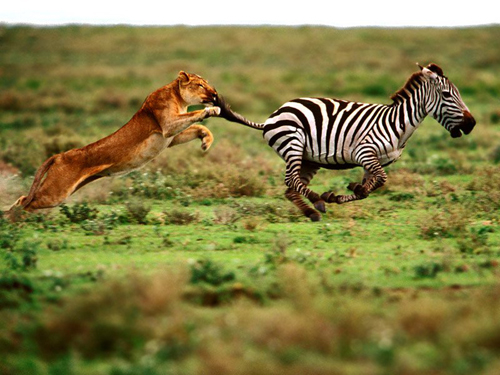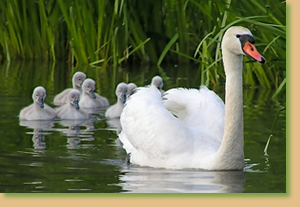- The idea that the strong survive by protecting themselves against dangers in the natural environment, while the weak are overcome by environmental conditions and dangers.
- Darwinists reduce this to organs and structures. They maintain that if mutations take place and a useful structure emerges as the result of mutations, then that will naturally be selected from among other, unsuccessful structures, and that as a result of that selection process the correct structures and organs will come into being.
- They reject the idea of chance when it comes to this subject. They say, “Mutations come about by chance, but natural selection determines the useful outcome.” They try to give the impression that a logical thing is going on through the idea of the selection of the most useful alternative from many possibilities.

Points that refute this claim:
- It is impossible for any mutation to take place that benefits a living thing or improves its physical structure. Mutations are 99% deleterious and 1% have no effect at all. No useful mutation HAS EVER BEEN OBSERVED. It is therefore impossible for “natural selection to select on the basis of useful mutations.”
- Natural selection is not a conscious mechanism. It has no consciousness with which to select the best from the mutations that arise.
- Even if the most useful structure is selected by way of natural selection, this state of affairs will still bestow no new structure on a life form. Fast-running zebras survive while the weak are hunted down, but this will never turn zebras into tigers.
- It is impossible for natural selection to act according to a pre-determined plan. That would be to claim that natural selection is
 conscious. It is a grave error of logic to maintain that random, unconscious events are actually conscious. But in order to escape the embarrassing effect of their claims of chance, Darwinists try to give the impression and deceive people into thinking that natural selection is conscious.
conscious. It is a grave error of logic to maintain that random, unconscious events are actually conscious. But in order to escape the embarrassing effect of their claims of chance, Darwinists try to give the impression and deceive people into thinking that natural selection is conscious.
- Darwinists claim that natural selection must plan an organ such as the eye before any such thing exists, know all its properties beforehand and bring about all the requisite stages according to a plan WHILE NEVER MAKING ANY ERROR. It must act according to a specific plan, making no errors, until an eye emerges. It must produce a succession of perfect structures, create a brain that sees the image and a consciousness to interpret what it sees. And it must do all these things simultaneously. It is of course impossible for unconscious atoms to do this. But that is still what Darwinists insist on claiming.
Darwinist confessions regarding natural selection
Charles Darwin:
The difficulties and objections may be classed under the following heads: ... Secondly, is it possible that an animal having, for instance, the structure and habits of a bat, could have been formed by the modification of some other animal with widely different habits and structure? Can we believe that natural selection could produce, on the one hand, an organ of trifling importance, such as the tail of a giraffe, which serves as a fly-flapper, and, on the other hand, an organ so wonderful as the eye? (Charles Darwin, The Origin of Species, Chapter VI, “Difficulties of the Theory.”)
 J. Hawkes:
J. Hawkes: I have difficulty in believing that the dazzling beauty in birds, fish, flowers, etc., came about by natural selection. Beyond that, he asks the question whether human consciousness can be the product of such a mechanism. In his article, finally, he concludes that the human mind that produced the blessings of civilization, and the creative imagination that immortalized those such as Socrates, Leonardo da Vinci, Shakespeare, Newton and Einstein cannot be the gift of the law of the jungle called the “struggle for survival” to us. (J. Hawkes, "Nine Tentalizing Mysteries of Nature," New York Times, no.33, 1957)
Dr. Colin Patterson:
No one has ever produced a [new] species by mechanisms of natural selection. No one has ever got near it and most of the current argument in neo-Darwinism is about this question. (Colin Patterson, “Cladistics,” BBC, Interview with Brian, Peter Franz, 4 March 1982.)
In the meantime, the educated public continues to believe that Darwin has provided all the relevant answers by the magic formula of random mutations plus natural selection—quite unaware of the fact that random mutations have turned out to be irrelevant and natural selection a tautology. (Arthur Koestler, Janus : A Summing Up, Vintage Books, 1978, p.185)
Pierre Paul Grassé:
The “evolution in action” of J. Huxley and other biologists is simply the observation of demographic facts, local fluctuations of genotypes, geographical distributions. Often the species concerned have remained practically unchanged for hundreds of centuries! Fluctuation as a result of circumstances, with prior modification of the genome, does not imply evolution, and we have tangible proof of this in many panchronic species. (Pierre Paul Grassé, Evolution On Living Organisms: Evidence for a New Theory of Information, Academic Press, January, 1978)


